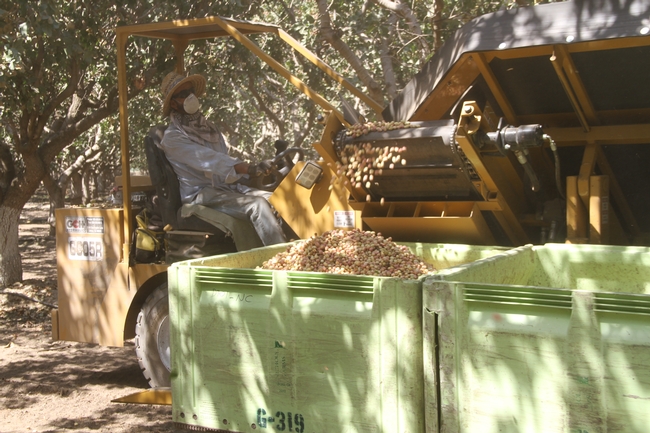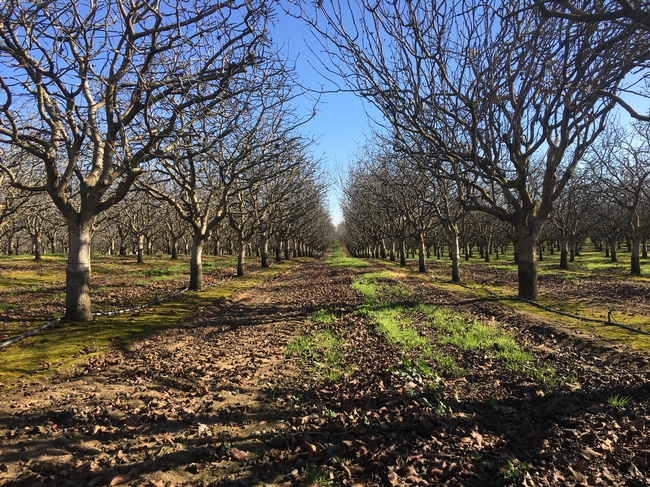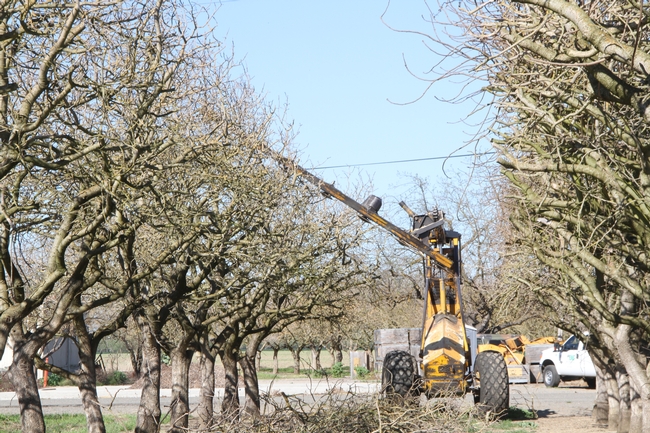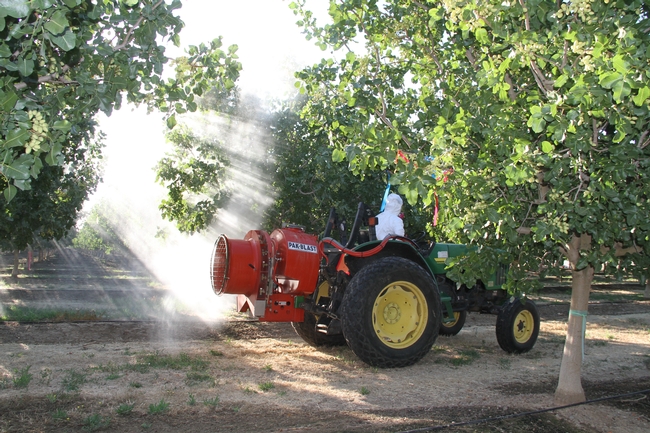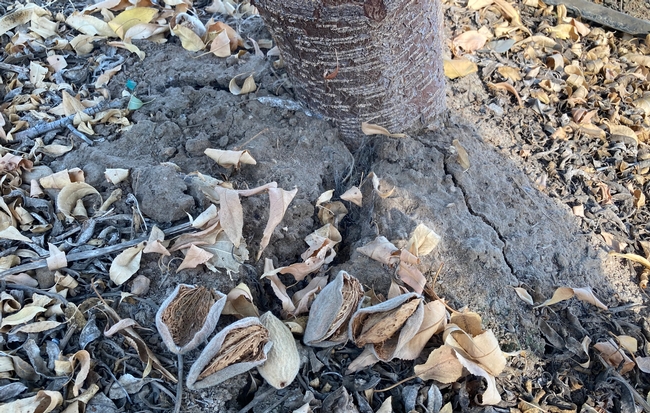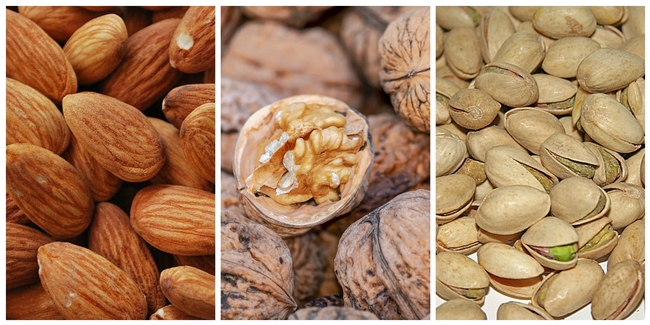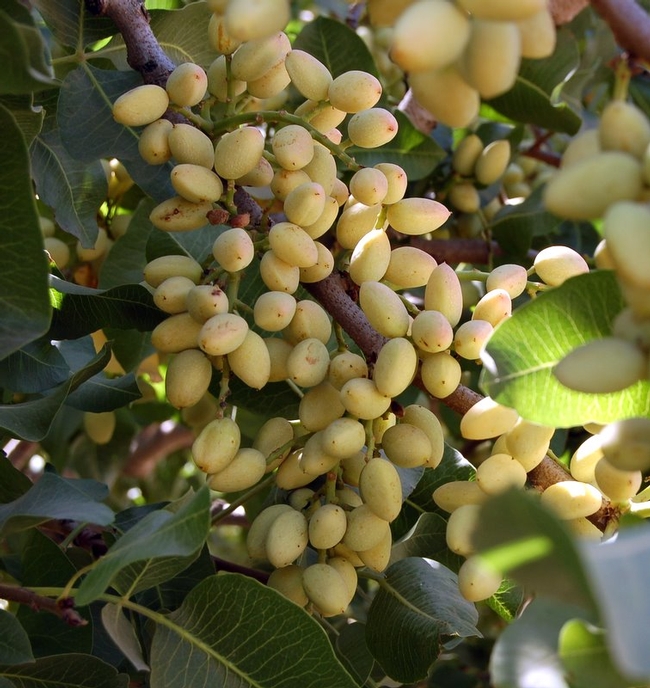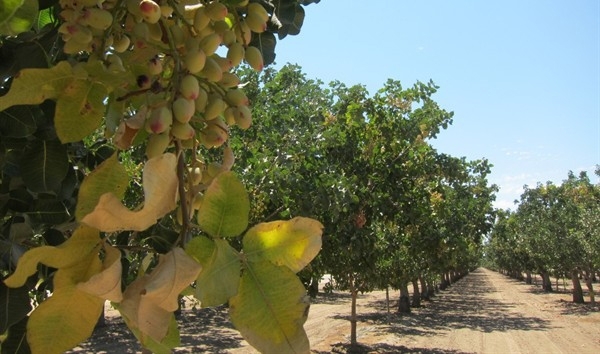Posts Tagged: pistachios
Pistachio production costs outlined in UC study
The popularity of pistachios as a healthy snack continues to drive demand. California's pistachio crop was valued at $1.94 billion in 2019, according to the California Department of Food and Agriculture.
For growers considering planting an orchard, the costs and returns of establishing and producing pistachios in the southern San Joaquin Valley are outlined in a new study by UC ANR's Agricultural Issues Center, UC Cooperative Extension and the UC Davis Department of Agricultural and Resource Economics.
“New growers use this information to create their budget for production loans for their bank,” said Jeffrey Gibbons, plant manager of Setton Pistachio of Terra Bella. “Owners use this information so they can be assured their farm managers are not overcharging them for farming costs. Farm managers use this information to see how they compare to the industry. Setton Pistachio uses this information to project budgets for future planting scenarios.”
UC Cooperative Extension specialists and farm advisors routinely refer people interested in planting pistachios to the cost study.
“I use this every time I have a new grower,” said Louise Ferguson, UC Cooperative Extension specialist in the UC Davis Department of Plant Sciences and co-author of the study. “It not only gives a good estimate of establishment and production costs, and projected net returns, but ensures no details are missed in planning. It is an invaluable template for pistachio production.”
Elizabeth Fichtner, UC Cooperative Extension orchard systems advisor for Kings and Tulare counties, agreed. “The cost study documents are one of the first resources I assemble for new growers.”
The new study estimates the costs and returns of establishing and producing pistachios using low-volume drip irrigation in the southern San Joaquin Valley. The hypothetical orchard is planted at 128 trees per acre, with an expected life span of 40 years.
The authors describe the assumptions used to identify current costs for pistachio establishment and production, material inputs, cash and non-cash overhead and a ranging analysis table, which shows profits over a range of prices and yields.
"Pistachio growers, potential future growers, land leasers, appraisers and loan officers benefit from detailed and current information included in the studies,” said Craig Kallsen, UCCE citrus and pistachio farm advisor for Kern County.
Gibbons said, “Setton Pistachio refers potential growers to this information as they determine if they want to plant pistachios. Setton Pistachio appreciates this information if it is current. If it is too old, it is not reliable, and there is no other good source for unbiased pistachio development information.”
For a grower, deciding not to plant pistachios based on information in the cost study can be just as economically valuable as deciding to plant pistachios based on the cost study, said Kallsen.
“The information in the cost study can prevent a grower from making a million-dollar mistake by planting a crop that is not suitable for their soil, water availability or for an economic reason not related to crop environment/adaption suitability such as length of time to first harvest or high cost of establishment,” he said.
Reliable estimated costs for a crop grown mostly in California may be hard to find from a source other than UC. This study was co-authored by 17 UCCE farm advisors and specialists and a pomology professor at California State University, Fresno, with input from growers.
“This study summarizes the knowledge learned and used to build California's pistachio industry from 40,000 acres in the 1970s to over 400,000 acres and a 1.1-billion-pound crop in 2020,” Ferguson said.
The new study, “Sample Costs to Establish and Produce Pistachios, Low-Volume Irrigation, San Joaquin Valley South - 2020” can be downloaded for free from the UC Davis Department of Agricultural and Resource Economics website http://coststudies.ucdavis.edu. Sample cost of production studies for many other commodities are also available on the website.
“UC cost studies are always something I alert potential growers to when they are considering whether to plant an orchard,” said Phoebe Gordon, UC Cooperative Extension orchard crops advisor for Madera and Merced counties. “New growers have expressed to me a few times that they find the cost study useful.”
For an explanation of calculations used in the study, refer to the section titled Assumptions. For more information contact Donald Stewart, University of California Agriculture and Natural Resources, Agricultural Issues Center, Department of Agricultural and Resource Economics, at (530) 752-4651 or destewart@ucdavis.edu. To discuss this study with a local UC Cooperative Extension advisor, find the UC Cooperative Extension office in your county at https://ucanr.edu/About/Locations.
A hike in navel orangeworm pressure expected later this century due to climate change
Outsized wildfires, rising sea levels and disappearing glaciers are dramatic signs of climate change, but not the only ones. New UC Agriculture and Natural Resources research provides forewarning of a change that will be economically and environmentally costly to California – a fifth generation of navel orangeworm, the most destructive pest of almonds, walnuts and pistachios.
Navel orangeworm (NOW) will be more problematic in the future because of warming temperatures, UC Cooperative Extension scientists report in Science of the Total Environment.
Like most insects,NOW's development rate, physiology, behavior and reproduction are highly dependent on the ambient temperature. When the weather warms in the spring, NOW moths emerge from the nuts left in the tree or on the ground during the winter. After mating, females then recycle those last year's nuts to lay eggs and complete one generation. Adults emerged from that first and subsequent generations then lay eggs on in-season hull-splitalmondnuts, where larvae feeding damages the crop. Typically the pests fly three to four times per year – with more flights in areas with warmer weather.
“Warmer temperatures can result in early activity of the pests in the spring and increased activity during the season,” said Tapan Pathak, the UC Cooperative Extension climate change specialist and the study's principle investigator.
The scientists looked at 10 climate models to determine what nut farmers can expect to face over the next 80 years and applied NOW developmental models to the changing climate. Daily maximum and minimum temperature data were obtained for 1950 to 2005, and future projections stretched to 2100.
“The fifth generation can happen in the next few decades,” said Jhalendra Rijal, UC integrated pest management advisor and co-author of the research. “The climate models suggest that spring will begin earlier. That causes insect activity to start earlier. With increased temperatures through the season, the number of days to complete a generation is less. At the end of 2050 or so, we'll see an extra generation.”
The study focused on 23 counties in the Central Valley, from Shasta County in the north to Kern County in the south, where 1.78 million bearing acres of nut crops are planted. About two-thirds of that acreage is planted to almonds, 20% in walnuts and 16% in pistachios. The tree nut crops were valued at more than $8 billion combined in 2018, according to the California Department of Food and Agriculture.
The completion of the NOW life cycle is faster in pistachio compared to almonds and walnuts, so the potential risk of crop damage and economic loss is higher in pistachio, according to the research report. There are only a few years historically in which the models detected the fifth generation of NOW in Kern County pistachios. The occurrence of the fifth generation in almonds and walnuts was historically nonexistent, but it starts appearing in three southern counties by 2040 and eleven counties by 2100.
“In order to alleviate some of the risks related to navel orangeworm damage to nut crops, it is important to implement integrated pest management practices,” Pathak said.
IPM preventative and control measures include sanitizing the orchard during the winter by removing all the nuts on the ground and in the trees, applying synthetic reproductive hormones to limit the pests' ability to find mates, encouraging natural enemies, judicious of least-toxic pesticides if necessary and harvesting the crop early to avoid a new generation of the pest.
“A better understanding of future navel orangeworm pressure on California's major nut crops can help facilitate and strategize integrated pest management practices in order to minimize production risks,” Pathak said.
The results of the research can also inform growers and pest control advisers about the potential increased threat from other pests as the climate changes.
California nut industry provides funds to hire four UC Cooperative Extension research associates
Four staff research associates will join the ranks of UC Cooperative Extension scientists in the coming months to support nut crop advisors conducting critical research in walnut, almond and pistachio production.
The California Walnut Board, the Almond Board of California and the California Pistachio Research Board together have provided about $425,000 to cover annual salaries, benefits, travel and equipment for the new UC Cooperative Extension staff. Under the terms of the agreement, the new positions will be funded annually for up to three years, pending available funds and success of the program.
“By supporting these new positions in UC Cooperative Extension, the California Walnut Board, the Almond Board of California and the California Pistachio Research Board show their recognition for the value of applied research conducted by our nut crop advisors,” said UC Agriculture and Natural Resources vice president Glenda Humiston. “We are grateful to these industry organizations for this vote of confidence and the generous funding to generate science-based knowledge to apply on California farms.”
The new research associates will each devote time supporting two advisors with tree nut assignments:
- Allan Fulton and Luke Milliron, serving Butte, Glenn and Tehama counties
- Katherine Jarvis-Shean and Franz Niederholzer, serving Colusa, Sacramento, Solano, Sutter, Yolo counties
- Mae Culumber and Phoebe Gordon, serving Fresno, Madera and Merced counties
- Elizabeth Fichtner and an advisor under recruitment, serving Tulare and Kings counties
The arrangement reflects a change in how UC Cooperative Extension supports the agriculture industries in California with applied research. With less funding from its traditional revenue sources – USDA, the state government and counties – advisors cover more territory than in the past. Over the years, they have also taken on an increasing share of UC's applied research mission serving the state's specialty crops industries.
The new staff research associate positions were crafted to attract highly qualified candidates who will support advisors' applied research efforts. Their primary focus will be on assisting advisors with planning, execution and gathering data on experimental and demonstration field trials.
UCCE advisor emeritus Joe Grant, who now serves as production research director of the California Walnut Board, chaired an industry working group that drafted the plan based on advisors' input about their needs.
“Advisors are competent and creative people with the skills and knowledge to do research. They need the same support that researchers on campus have,” Grant said.
The California Pistachio Research Board previously provided funding for a plant pathology researcher and an integrated pest management advisor at the UC Kearney Agricultural Research and Extension Center in Parlier. In addition, the board supported creation of $1 million endowments for a nut genetics researcher and a tree nut soil science and plant-water relations researcher as part of an initiative co-funded by UC President Janet Napolitano.
“We've been concerned for a long time about UC Cooperative Extension's research capacity and infrastructure issues,” said Bob Klein, manager of the California Pistachio Research Board. “This new initiative will increase efficiency and productivity for farm advisors and also reduce their stress from being overcommitted.”
Josette Lewis, the Almond Board chief scientific officer, said the organization depends on UCCE farm advisors for unbiased, quality information about almond production.
“Advisors are a valuable link between UC campuses and growers, not only in doing applied research that helps growers thrive, but in meeting California's goals of environmental and social sustainability,” Lewis said. “The information they generate is shared with a host of ag industry professionals – pest control advisers, crop consultants and people in the private sector who provide services to growers.”
Commodity industry funding for UC Cooperative Extension reflects the value the nut crop industries leverage from one of the strongest agricultural research and extension systems in the world, Lewis said.
The new program is modeled after a pilot project in Colusa County in which the Almond Board provided funding for Niederholzer to hire an intern to support almond research. A young scientist who held the post from 2015-16 was Milliron. In 2017, UC Cooperative Extension named Milliron a sustainable orchard systems advisor for Butte, Glenn and Tehama counties and he will now supervise one of the new staff research associates.
“We had a chance to keep him in the system and capitalize on what he learned during his internship,” Lewis said.
There are other tree nut and fruit advisors in need of research help, Grant said. For example, there are concentrations of tree fruit and nut acreage and growers in Kern, San Joaquin and Stanislaus counties.
“We positioned these four research associates where we heard the need for help was most critical. We can see adding another position or two in the future if funds are available,” Grant said.
Climate and California agriculture of the future
One of the forces driving agricultural experiments in California's fertile San Joaquin Valley is climate change, reported Mark Schapiro on Grist.org. Although some sources still don't feel completely comfortable with the concept.
"Whether it's carbon built up in the atmosphere or just friggin' bad luck, the conditions are straining us," said John Duarte, president of Duarte Nursery.
The state's fruit and nut orchards are taking the most heat as conditions change. A fruit or nut tree planted today may be ill-suited to climatic conditions by the time it begins bearing fruit in 5 or 10 years. Between 1950 and 2009, “chill” hours trees needed annually to reboot trees' metabolic system for the spring bloom had already declined by as much as 30 percent, according to a California Department of Food and Agriculture study.
“If trees haven't had that low-chill period when they wake up in the spring, it's like being up all night and then trying to go to work.” said Mae Culumber, a nut crop advisor with UC Cooperative Extension in Fresno County.
Researchers have already observed that cherry, apricot, pear, apple, pecan and almond trees are often less productive than they used to be.
The article said farmers may turn to pistachio trees to weather a warmer and dryer California. Pistachio trees require one-third to one-half as much water as almond trees. During droughts, pistachio tree metabolism slows and when water returns, they start producing nuts again. And they can produce nuts for 80 years or longer, almost four times the life span of an average almond tree.
For field crops, scientists are looking at improving the soil and transforming growing systems to help farmers adapt to the warming climate.
“When I drive to the Central Valley, I get goosebumps; I feel the urgency,” UC Davis agronomist Amélie Gaudin said. “I see an agriculture that is basically hydroponics. It's like a person being fed/kept alive by an IV.”
“What happens when you no longer have the sugar-water?” she adds.
Gaudin is focusing on using agroecological principles to develop efficient and resilient cropping systems. Planting cover crops and reducing tillage show promise for mitigating the impact of climate change in the valley.
UC ANR announces recipients of first two $1 million endowed chairs

The UCCE citrus and pistachio crops advisor in Kern County, Craig Kallsen, is the UC Cooperative Extension Presidential Chair for Tree Nut Genetics, and UCCE integrated orchard management specialist Bruce Lampinen, based at UC Davis, is the UC Cooperative Extension Presidential Chair for Tree Nut Soil Science and Plant Water Relations. The endowed chairs will give the two scientists a dedicated source of funding for five years, when the chairs are reopened for review.
UC ANR established the two $1 million endowments for the endowed chairs last year. Half the funding was provided by UC President Janet Napolitano; the other half was donated by the California Pistachio Research Board. Establishment of the endowed chairs was announced last year by UC ANR vice president Glenda Humiston.
“I'm pleased that we have identified two exceptional research programs to support with the first endowed chairs in the more than 100-year history of UC Cooperative Extension,” Humiston said. “I feel certain Craig and Bruce will make significant advances in pistachio production systems under California conditions.”
Pistachio breeding program
Kallsen said the endowment comes at a particularly opportune time for the UC pistachio breeding research program. In cooperation with UC Davis pomology researcher Dan Parfitt, Kallsen has been breeding pistachios as part of a variety selection program using conventional methods - manually crossing and then growing trees to determine whether they have beneficial characteristics.
“Breeding new varieties this way takes a while, especially in pistachios,” Kallsen said. “They don't bloom for four or five years. With some trials we are just now at the stage where it gets interesting. The funding will be helpful for evaluating the new progeny.”
Kallsen is looking for pistachio varieties that show novel nut, tree growth and yield characteristics, and for varieties that produce a high yield even under low-chill conditions.
“The climate appears to be warming,” Kallsen said. “That poses a problem for pistachios, because our current cultivars have a significant chilling requirement that has not always been met when we don't have cold, foggy winters.”
Kallsen plans to establish a trial pistachio orchard at the UC Riverside Coachella Valley Agricultural Research Station, where winter weather rarely dips to sufficient chill levels, to see which varieties produce acceptable crops under the warmer conditions.
Another key objective of the UC breeding program is identifying pistachio cultivars that mature at different times. At the moment, 90 percent of California pistachios are the Kerman variety. They all mature at the same time, putting pressure on harvesting, transportation, processing and storage resources.
“Ten years ago, UC introduced the Golden Hills variety, which matures about two weeks earlier. It now represents 5 or 10 percent of the state's crop,” Kallsen said. “We're looking closely at another potential cultivar that matures 10 days before Golden Hills.”
Pistachio research at UC Davis
Lampinen has devoted most of his career to almond and walnut research, but has worked on pistachios in collaboration with other UCCE specialists and advisors since 2009, focusing mainly on canopy light interception and salinity and their impacts on pistachio yield and water use.
Lampinen said his current work on almond and walnut water use as related to canopy size will be expanded to pistachio with the funding from the endowment.
“Some preliminary data on this is currently being gathered, but there is a need to expand this work to a wider range of orchard ages and planting configurations,” Lampinen said. “It will be very useful to have the ongoing support from an endowment.”
Lampinen's work in almonds and walnuts will also inform new pistachio research approaches. For example, Lampinen developed a no-pruning system for establishing new walnut orchards, and will study whether a similar approach in pistachio would make sense. For decades, California farmers believed that pruning young walnut trees was critical to healthy tree development. Lampinen observed unpruned walnut orchards in France, and “they looked perfectly fine,” he said.
Lampinen's research showed that pruning in the early years of tree development reduced water use efficiency and decreased walnut yields. By not pruning young trees, farmers could cut back significantly on labor costs and eliminate the need to dispose of the vegetation cut off the tree while using water more efficiently.
The no-pruning approach is now widely accepted in almonds and walnuts. With funding from the five-year endowment, he plans to compare the impacts of the alternative pruning systems on newly established pistachio orchards.
In addition, Lampinen said he plans to consult with pistachio industry leaders, growers and farm advisors to develop an effective research program on pistachio soil and water relations.
